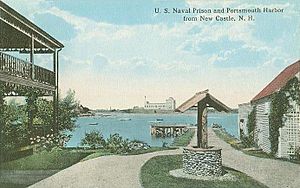Portsmouth Naval Prison facts for kids
The Portsmouth Naval Prison is a building that looks like a castle. It used to be a prison for the U.S. Navy and Marine Corps. It is located at the Portsmouth Naval Shipyard in Kittery, Maine. This strong concrete prison was used from 1908 until 1974.
Contents
Early History: Fort Sullivan and Camp Long
The land where the prison stands was first used in 1775 during the American Revolutionary War. Soldiers from New Hampshire, led by General John Sullivan, built a defense called Fort Sullivan there. This fort, along with another across the Piscataqua River, helped guard the water path to Portsmouth. The soldiers left about three years later.
The fort was used again in 1814 during the War of 1812. In 1861, it was rebuilt to protect Portsmouth from attacks. After 1866, Fort Sullivan was taken apart.
Later, a camp called Camp Long was built nearby. It was named after Secretary of the Navy John Davis Long. During the Spanish–American War in 1898, this camp held over 1,600 Spanish prisoners. They stayed there until they were sent back to Spain.
The "Alcatraz of the East"
When Camp Long was removed in 1901, the site became available for a new naval prison. The prison was built between 1905 and 1908. It was designed to be like Alcatraz, located on an island with strong tidal currents to make escapes very difficult.
The first Navy prisoners arrived in 1908. Colonel Allan C. Kelton of the Marine Corps was in charge. Later, Marine prisoners were also kept there. The tall, castle-like tower in the middle, with its copper roof, was added in 1912.
In 1917, Lieutenant Commander Thomas Mott Osborne took command. He was known as "the Father of Naval Corrections." Osborne wanted to make the prison better. He even went undercover inside the prison to see what changes were needed, including living conditions for the prisoners.
During World War I, the prison held many wartime prisoners. The number of prisoners reached its highest point of 2,295 in 1918. Two more sections were added to the prison later. A northeast wing was built in 1942, and a southwest wing, called "the Fortress," was added in 1943. The prison's maximum number of prisoners reached 3,088 in 1945.
After World War II
After World War II ended in Europe in May 1945, some German U-boats surrendered to the United States Navy. These submarines were brought to the Portsmouth Naval Shipyard. Engineers there wanted to study their design.
The Office of Naval Intelligence (ONI) had people at the prison to question the submarine crews. This information was kept secret at the time. It was important for learning about German submarine, jet aircraft, ballistic missile, and guided bomb technology. For example, one U-boat, U-234, was heading to Japan carrying important materials and new weapons technology.
When the U-boats arrived, there wasn't enough preparation. Items belonging to the U-boat crewmen were scattered during searches for information. These items were then piled up in the prison lobby. Some of these personal items were taken by prison guards.
The Cold War Era
The prison continued to be used during the Korean War and almost until the end of the Vietnam War. People on boats passing by the prison in warmer months could often hear shouts and whistles from the windows of "the Fortress."
In 1974, the Department of Defense created a new plan for military prisons. Prisoners would be placed based on their military branch, how long their sentence was, and where they were located. This new system made the Portsmouth Naval Prison, which had been built to be a modern facility, no longer needed.
After holding about 86,000 military prisoners over 66 years, the prison closed in 1974. The Navy briefly used the prison in the early 1980s to train officers who would work in military corrections.
In Popular Culture
The Portsmouth Naval Prison has appeared in several movies and books:
- In the 1973 movie The Last Detail, a sailor named Larry Meadows is being taken to the Portsmouth Naval Prison.
- In W. E. B. Griffin's novel Semper Fi, a character named Corporal Kenneth McCoy is assigned to transport prisoners to the Portsmouth Naval Prison.
- An episode of the TV series Baa Baa Black Sheep mentions a character being sent to Portsmouth.
- The prison is mentioned in Stephen King's 1982 story The Body, which was later made into the movie Stand by Me.
- The prison and shipyard were used to look like a Russian shipyard in the 1978 TV film The Defection of Simas Kudirka.
- The shipyard is mentioned in the 1979 novel The Short-Timers, which became the 1987 film Full Metal Jacket.
No Longer Used
The prison building was once considered for renting out and fixing up. A local developer thought it would cost a lot of money to turn the huge building into offices. This would include removing old paint and other materials.
However, plans to change the prison stopped after the developer passed away in 2000. All plans were completely given up after security at military bases became much tighter following the events of September 11, 2001.
|



